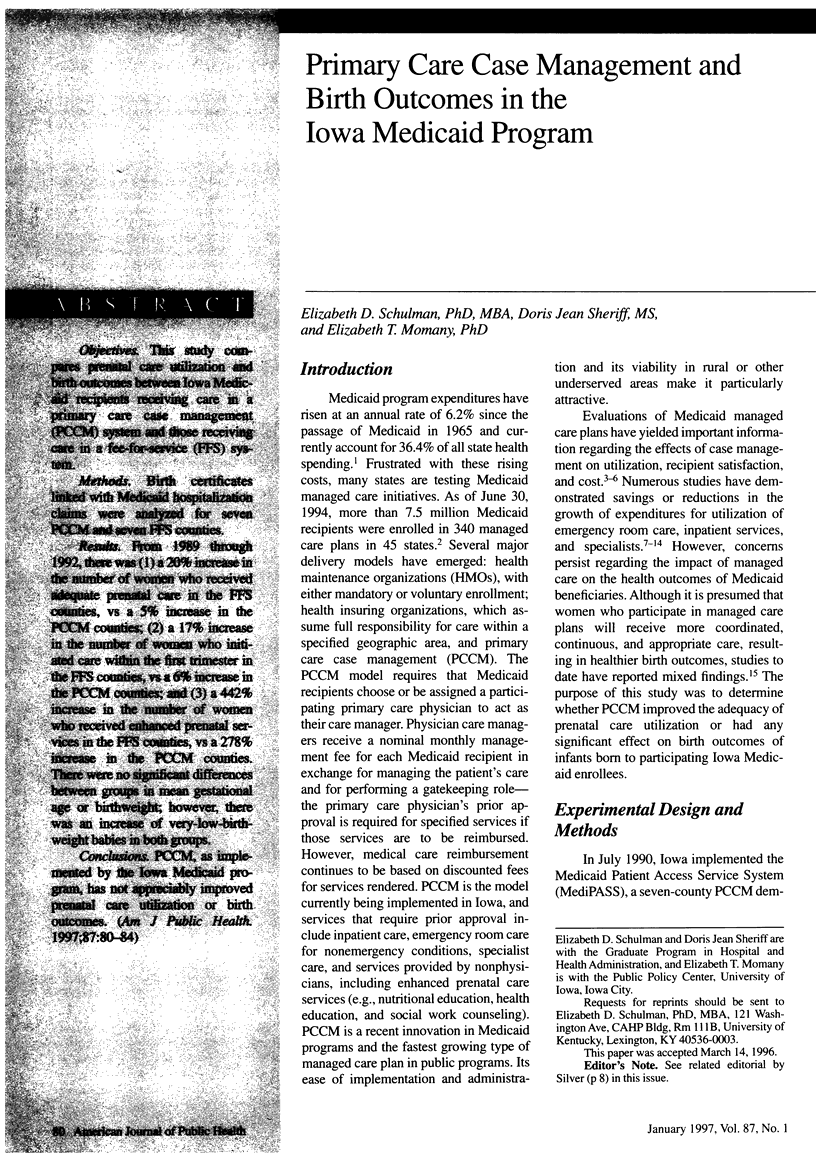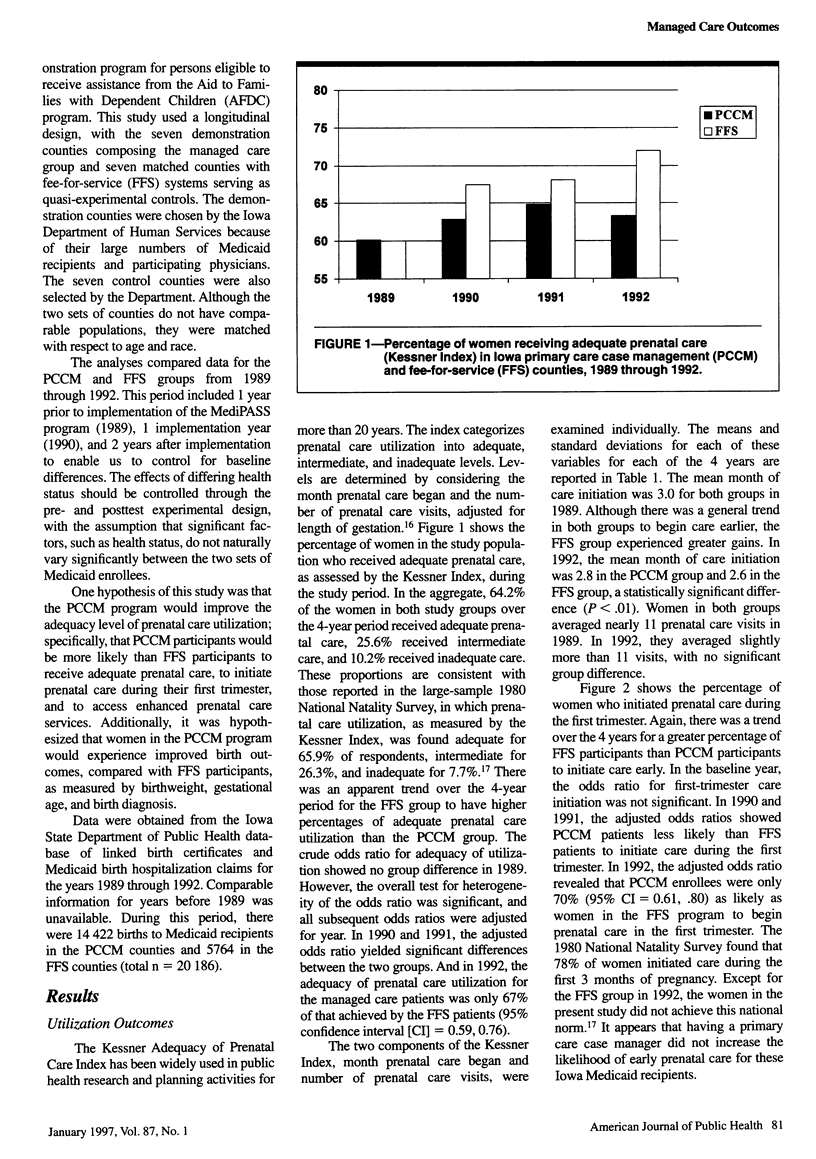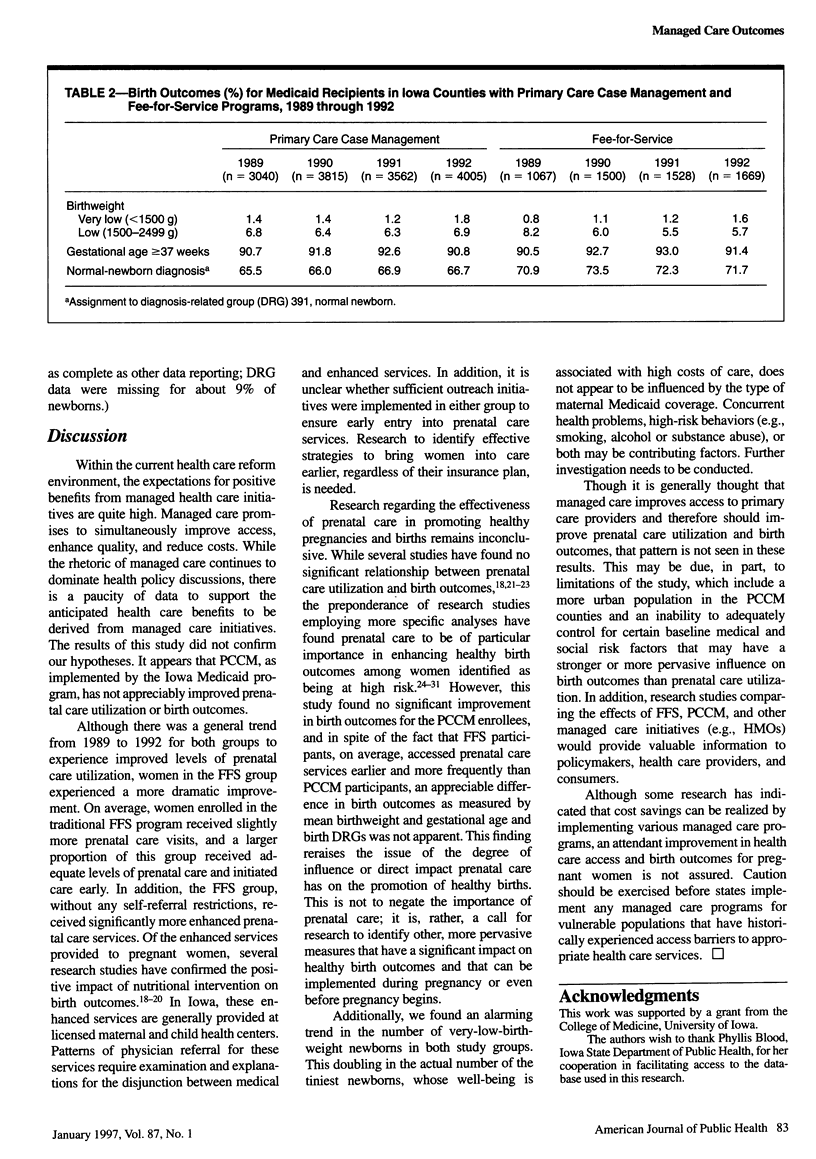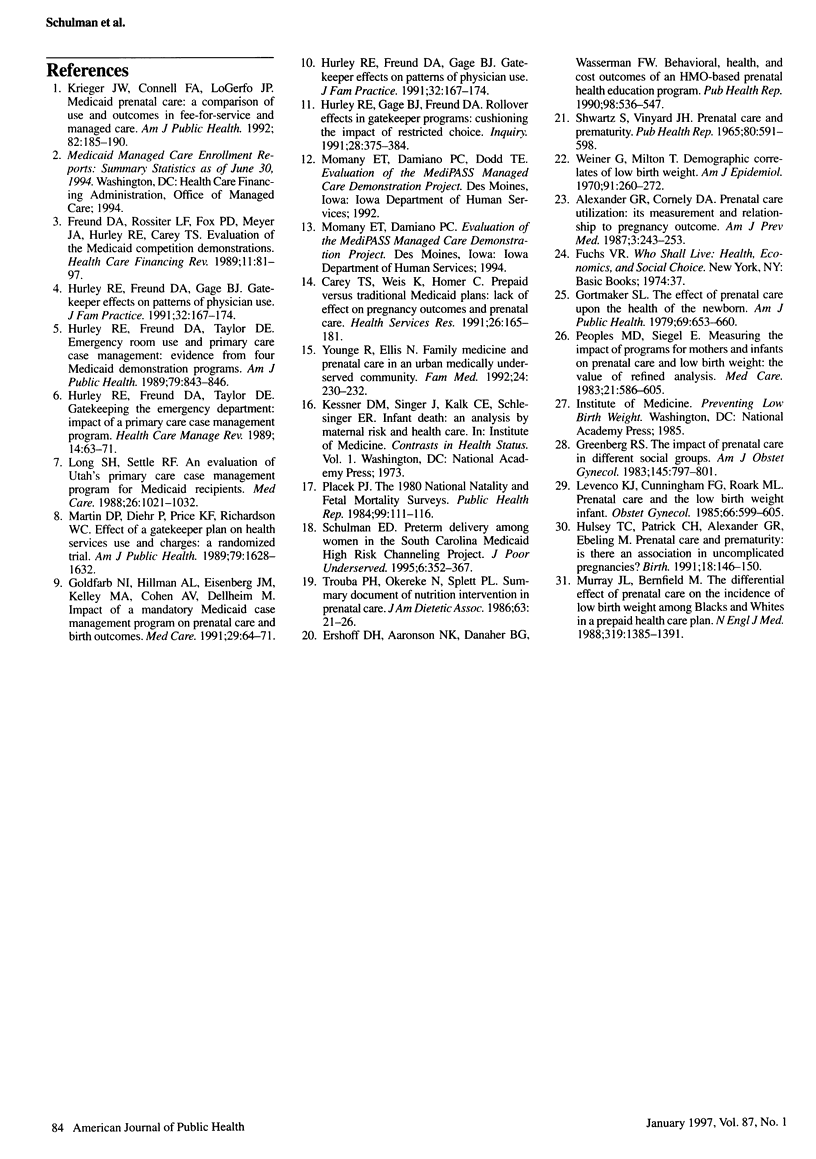Abstract
OBJECTIVES: This study compares prenatal care utilization and birth outcomes between Iowa Medicaid recipients receiving care in a primary care case management (PCCM) system and those receiving care in a fee-for-service (FFS) system. METHODS: Birth certificates linked with Medicaid hospitalization claims were analyzed for seven PCCM and seven FFS counties. RESULTS: From 1989 through 1992, there was (1) a 20% increase in the number of women who received adequate prenatal care in the FFS counties, vs a 5% increase in the PCCM counties; (2) a 17% increase in the number of women who initiated care within the first trimester in the FFS counties, vs a 6% increase in the PCCM counties; and (3) a 442% increase in the number of women who received enhanced prenatal services in the FFS counties, vs a 278% increase in the PCCM counties. There were no significant differences between groups in mean gestational age or birthweight; however, there was an increase of very-low-birthweight babies in both groups. CONCLUSIONS: PCCM, as implemented by the Iowa Medicaid program, has not appreciably improved prenatal care utilization or birth outcomes.
Full text
PDF




Selected References
These references are in PubMed. This may not be the complete list of references from this article.
- Alexander G. R., Cornely D. A. Prenatal care utilization: its measurement and relationship to pregnancy outcome. Am J Prev Med. 1987 Sep-Oct;3(5):243–253. [PubMed] [Google Scholar]
- Carey T. S., Weis K., Homer C. Prepaid versus traditional Medicaid plans: lack of effect on pregnancy outcomes and prenatal care. Health Serv Res. 1991 Jun;26(2):165–181. [PMC free article] [PubMed] [Google Scholar]
- Ershoff D. H., Aaronson N. K., Danaher B. G., Wasserman F. W. Behavioral, health, and cost outcomes of an HMO-based prenatal health education program. Public Health Rep. 1983 Nov-Dec;98(6):536–547. [PMC free article] [PubMed] [Google Scholar]
- Freund D. A., Rossiter L. F., Fox P. D., Meyer J. A., Hurley R. E., Carey T. S., Paul J. E. Evaluation of the Medicaid competition demonstrations. Health Care Financ Rev. 1989 Winter;11(2):81–97. [PMC free article] [PubMed] [Google Scholar]
- Goldfarb N. I., Hillman A. L., Eisenberg J. M., Kelley M. A., Cohen A. V., Dellheim M. Impact of a mandatory Medicaid case management program on prenatal care and birth outcomes. A retrospective analysis. Med Care. 1991 Jan;29(1):64–71. doi: 10.1097/00005650-199101000-00006. [DOI] [PubMed] [Google Scholar]
- Gortmaker S. L. The effects of prenatal care upon the health of the newborn. Am J Public Health. 1979 Jul;69(7):653–660. doi: 10.2105/ajph.69.7.653. [DOI] [PMC free article] [PubMed] [Google Scholar]
- Greenberg R. S. The impact of prenatal care in different social groups. Am J Obstet Gynecol. 1983 Apr 1;145(7):797–801. doi: 10.1016/0002-9378(83)90681-6. [DOI] [PubMed] [Google Scholar]
- Hulsey T. C., Patrick C. H., Alexander G. R., Ebeling M. Prenatal care and prematurity: is there an association in uncomplicated pregnancies? Birth. 1991 Sep;18(3):146–150. doi: 10.1111/j.1523-536x.1991.tb00085.x. [DOI] [PubMed] [Google Scholar]
- Hurley R. E., Freund D. A., Gage B. J. Gatekeeper effects on patterns of physician use. J Fam Pract. 1991 Feb;32(2):167–174. [PubMed] [Google Scholar]
- Hurley R. E., Freund D. A., Taylor D. E. Emergency room use and primary care case management: evidence from four Medicaid demonstration programs. Am J Public Health. 1989 Jul;79(7):843–846. doi: 10.2105/ajph.79.7.843. [DOI] [PMC free article] [PubMed] [Google Scholar]
- Hurley R. E., Freund D. A., Taylor D. E. Gatekeeping the emergency department: impact of a Medicaid primary care case management program. Health Care Manage Rev. 1989 Spring;14(2):63–71. doi: 10.1097/00004010-198901420-00008. [DOI] [PubMed] [Google Scholar]
- Hurley R. E., Gage B. J., Freund D. A. Rollover effects in gatekeeper programs: cushioning the impact of restricted choice. Inquiry. 1991 Winter;28(4):375–384. [PubMed] [Google Scholar]
- Krieger J. W., Connell F. A., LoGerfo J. P. Medicaid prenatal care: a comparison of use and outcomes in fee-for-service and managed care. Am J Public Health. 1992 Feb;82(2):185–190. doi: 10.2105/ajph.82.2.185. [DOI] [PMC free article] [PubMed] [Google Scholar]
- Leveno K. J., Cunningham F. G., Roark M. L., Nelson S. D., Williams M. L. Prenatal care and the low birth weight infant. Obstet Gynecol. 1985 Nov;66(5):599–605. [PubMed] [Google Scholar]
- Long S. H., Settle R. F. An evaluation of Utah's primary care case management program for Medicaid recipients. Med Care. 1988 Nov;26(11):1021–1032. doi: 10.1097/00005650-198811000-00001. [DOI] [PubMed] [Google Scholar]
- Martin D. P., Diehr P., Price K. F., Richardson W. C. Effect of a gatekeeper plan on health services use and charges: a randomized trial. Am J Public Health. 1989 Dec;79(12):1628–1632. doi: 10.2105/ajph.79.12.1628. [DOI] [PMC free article] [PubMed] [Google Scholar]
- Murray J. L., Bernfield M. The differential effect of prenatal care on the incidence of low birth weight among blacks and whites in a prepaid health care plan. N Engl J Med. 1988 Nov 24;319(21):1385–1391. doi: 10.1056/NEJM198811243192105. [DOI] [PubMed] [Google Scholar]
- Peoples M. D., Siegel E. Measuring the impact of programs for mothers and infants on prenatal care and low birth weight: the value of refined analyses. Med Care. 1983 Jun;21(6):586–608. doi: 10.1097/00005650-198306000-00002. [DOI] [PubMed] [Google Scholar]
- Placek P. J. The 1980 National Natality Survey and National Fetal Mortality Survey--methods used and PHS agency participation. Public Health Rep. 1984 Mar-Apr;99(2):111–116. [PMC free article] [PubMed] [Google Scholar]
- Schulman E. D. Preterm delivery among women in the South Carolina Medicaid High Risk Channeling Project. J Health Care Poor Underserved. 1995;6(3):352–367. doi: 10.1353/hpu.2010.0053. [DOI] [PubMed] [Google Scholar]
- Wiener G., Milton T. Demographic correlates of low birth weight. Am J Epidemiol. 1970 Mar;91(3):260–272. doi: 10.1093/oxfordjournals.aje.a121135. [DOI] [PubMed] [Google Scholar]
- Younge R., Ellis N. Family medicine and prenatal care in an urban medically underserved community. Fam Med. 1992 Mar-Apr;24(3):230–232. [PubMed] [Google Scholar]


